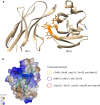Small molecule inhibitors against PD-1/PD-L1 immune checkpoints and current methodologies for their development: a review
- PMID: 33906641
- PMCID: PMC8077906
- DOI: 10.1186/s12935-021-01946-4
Small molecule inhibitors against PD-1/PD-L1 immune checkpoints and current methodologies for their development: a review
Abstract
Programmed death-1/programmed death ligand-1 (PD-1/PD-L1) based immunotherapy is a revolutionary cancer therapy with great clinical success. The majority of clinically used PD-1/PD-L1 inhibitors are monoclonal antibodies but their applications are limited due to their poor oral bioavailability and immune-related adverse effects (irAEs). In contrast, several small molecule inhibitors against PD-1/PD-L1 immune checkpoints show promising blockage effects on PD-1/PD-L1 interactions without irAEs. However, proper analytical methods and bioassays are required to effectively screen small molecule derived PD-1/PD-L1 inhibitors. Herein, we summarize the biophysical and biochemical assays currently employed for the measurements of binding capacities, molecular interactions, and blocking effects of small molecule inhibitors on PD-1/PD-L1. In addition, the discovery of natural products based PD-1/PD-L1 antagonists utilizing these screening assays are reviewed. Potential pitfalls for obtaining false leading compounds as PD-1/PD-L1 inhibitors by using certain binding bioassays are also discussed in this review.
Keywords: Cancer; Immunotherapy; Natural products; PD-1/PD-L1; Small molecules.
Conflict of interest statement
The authors declare no competing financial interests.
Figures





References
Publication types
LinkOut - more resources
Full Text Sources
Other Literature Sources
Research Materials

